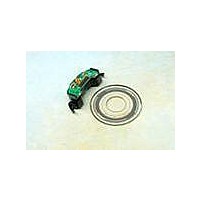AEDS-9340-W00 Avago Technologies US Inc., AEDS-9340-W00 Datasheet - Page 2

AEDS-9340-W00
Manufacturer Part Number
AEDS-9340-W00
Description
Z11,Dig,6ch,2500CPR
Manufacturer
Avago Technologies US Inc.
Series
AEDS-9340r
Type
Optical Encoderr
Datasheet
1.HEDS-8950.pdf
(15 pages)
Specifications of AEDS-9340-W00
Encoder Type
Optical
Output Type
Quadrature with Index (Incremental)
Pulses Per Revolution
2500
Voltage - Supply
5VDC
Actuator Type
Codewheel Not Included
Detent
No
Built In Switch
No
Mounting Type
Chassis Mount
Termination Style
Terminal Pins
Detents
No
Motion
Rotary
Number Of Channels
6
Index Output
Indexed
Encoder Signal
Digital Square Wave
Shaft Style
Hollow
Operating Supply Voltage (typ)
5VDC
Operating Temperature Min Deg. C
-10C
Operating Temperature Max Deg. C
85C
Terminal Type
PC Pins
Supply Voltage
5 V
Product
Optical
Technology
Rotary
Lead Free Status / RoHS Status
Lead free / RoHS Compliant
Orientation
-
Rotational Life (cycles Min)
-
Lead Free Status / Rohs Status
Compliant
2
Theory of Operation
The AEDB-9340 optical encoder is a emitter-detector
module. Coupled with codewheel, these modules trans-
late the rotary motion of a shaft into six-channel digital
output.
The modules contain a single Light Emitting Diode
(LED) as light source. The light is collimated into a
parallel beam by means polycarbonate lens located
directly over the LED. Opposite the emitter is a detector
IC. This IC consists of multiple sets of photo detectors
and signal processing circuitry necessary to produce
digital waveforms output.
The codewheel rotates between the emitter and detec-
tor, causing the light beam to be interrupted by pattern
of spaces and bars on the codewheel.
The Photodiodes that detect these interruptions are
arranged in a pattern that corresponds to the radius
and design of the codewheel. These detectors are also
spaced in such away that light period on one pair of
detectors corresponds to dark period on adjacent pair
of detectors.
The photodiode outputs are then fed through the signal
processing circuitry resulting in A, A, B, B, I, and I.
Comparators receive these signals and produce the final
outputs for channels A and B. Due to this integrated
phasing technique, the digital output of channel A is
in quadrature with that of channel B (90 degrees out of
phase). The commutation feedback (U, V, W) signals
are generated based on the codewheel design.
Definitions
Cycles (N): The number of electrical cycles per
revolution (CPR). Note: CPR refers to the raw signal from
encoder, that is the cycles before 4x decode.
One Cycle: 360 electrical degrees ( e).
One Shaft Rotation: 360 mechanical degrees.
Cycle Error (DC): An indication of cycle uniformity. The
difference between an observed shaft angle which gives
rise to one electrical cycle, and the nominal angular
increment of 1/N of a revolution.
Pulse Width (P): The number of electrical degrees that
an output is high during 1 cycle. This value is nominally
180 e or 1/2 cycle.
Pulse Width Error (D P): The deviation, in electrical
degrees, of the pulse width from its ideal value of 180 e.
State Width (S): The numbers of electrical degrees
between transitions in the output of channel A and the
neighboring transition in the output of channel B. There
are 4 states per cycle, each nominally 90 e.
State Width Error (D S): The deviation, in electrical
degrees, of each state width from its ideal value of 90 e.
Commutation Accuracy (D I): The deviation, in
mechanical degrees, after shaft rotates passing the
reference point (Index channel) to the first Channel-U
pulse. The measurement from middle of Channel-I to
rising edge of Channel-U.
Phase (f): The numbers of electrical degrees between
the center of the high state of channel A and the center
of the high state of channel B. This value is nominally
90 e for quadrature output.
This value is nominally 90 e for quadrature output.
Phase Error (Df ): The deviation of the phase from its
ideal value of 90 e.
Direction of Rotation: When the codewheel rotates in
the clockwise direction viewing from top of the
module (direction from pin U to B), channel A will lead
channel B. If the codewheel rotates in the opposite
direction (direction from pin B to U), channel B will
lead channel A.
Optical Radius (Rop): The distance from the
codewheel’s center of rotation to the optical center
(O.C.) of the encoder module.
Index Pulse Width (Po): The number of electrical
degrees that an index is high with reference to channel
A or channel B during one full shaft rotation.

















